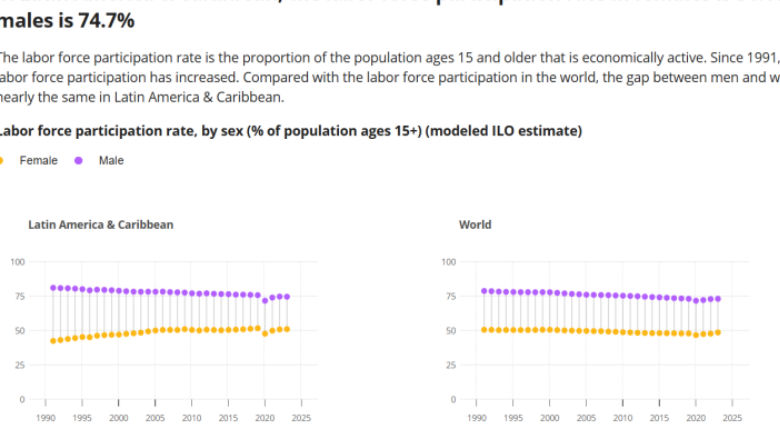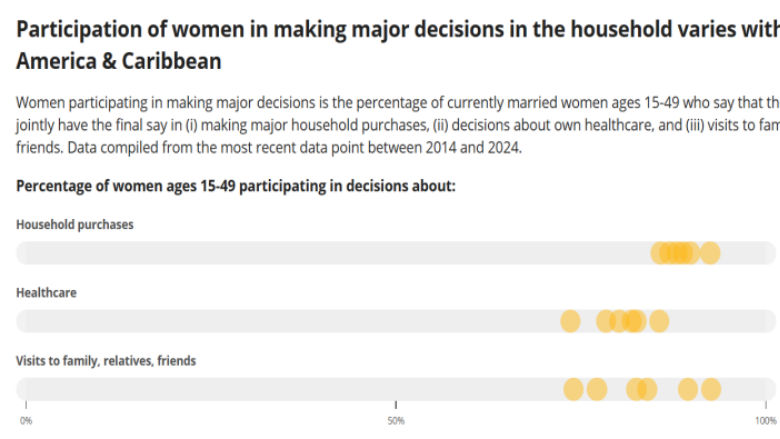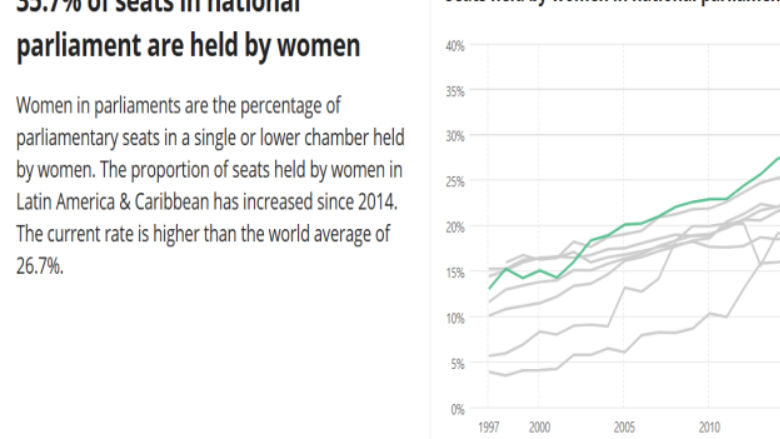-
Latin America and the Caribbean Gender Innovation Lab (LACGIL)
Highlights
-
Addressing Teenage Pregnancy in Latin America and the CaribbeanWebinar Mar 27, 2025
Addressing Teenage Pregnancy in Latin America and the Caribbean
The objective of this LACGIL webinar was to inform of the latest innovative interventions to reduce teenage pregnancy in the region, such as an innovative peer-led intervention in Brazil.
-
Addressing Teenage Pregnancy in Latin America and the CaribbeanInfographic Mar 26, 2025
Addressing Teenage Pregnancy in Latin America and the Caribbean
Latin America and the Caribbean has the second-highest teenage pregnancy rate in the world: 52 of every 1,000 girls aged 15-19 gave birth in this region in 2022 vs. the world average of 39.
-
Policy Brief Mar 12, 2025
Across the world most teachers are female, but most school administrators are male. Qualified female candidates often fail to apply for these management positions.
-
2025 LAC Country Gender ScorecardsGender Scorecards Feb 28, 2025
2025 LAC Country Gender Scorecards
The Latin America and the Caribbean Country Gender Scorecards is a comprehensive tool designed to provide country-specific insights for monitoring and benchmarking gender equality across 11 priority areas.
-
Webinar Dec 08, 2024
This session (in Spanish) reported on migration patterns in LAC, identified the profiles and risks faced by people on the move, particularly women and the LGBTI community.
-
Blog Dec 04, 2024
In Peru, half of the women report having been victims of some form of violence by their partners, and 59 percent of Peruvians show tolerance towards violence against women, as reported by the ENARES.
-
Blog Oct 08, 2024
Every year in Central America and the Dominican Republic, countless girls are born with boundless potential and aspirations. However, as they grow, many face obstacles that hinder their ability to pursue these dreams.
LAC Indicators
-
Indicator
The maternal mortality ratio in Latin America & Caribbean has remained stagnant over the last 20 years roughly around 88.
-
Indicator
In Latin America & Caribbean, the rate of adolescent fertility has decreased since 2014. The rate in 2022 was higher than the world average.
-
Indicator
The rates for girls and boys completing lower secondary school in Latin America & Caribbean are roughly the same as the global rates (girls: 77, boys: 76.3).
-
Indicator
The adult literacy rates for both women and men in Latin America & Caribbean are higher than the global rates.
-
Indicator
The labor force participation rate is the proportion of the population ages 15 and older that is economically active.
-
Indicator
Vulnerable employment among women is 32.7% and among men is 32.9%.
-
Indicator
The data, expressed as a proportion of time in a day, measure the average time an individual spends on household provision of services for own consumption.
-
Indicator
Share of business is calculated as the proportion of female or male newly registered limited liability company owners out of the total number of newly registered limited liability company owners.
-
Indicator
The gap in account ownership between men and women in LAC, 6.8, is larger than the gap of the world aggregate, 4.4.
-
Indicator
Ownership of a house is defined as any person who owned a house alone, jointly with their spouse, or both alone and jointly.
-
Indicator
Currently married women ages 15-49 who say that they alone or jointly have the final say in (i) making major household purchases, (ii) decisions about own healthcare, and (iii) visits to family, relatives, friends.
-
Indicator
Proportion of women who have ever experienced intimate partner violence is the percentage of ever-married women (ages 15 - 49) who have ever experienced physical or sexual violence committed by their husband or partner.
-
Indicator
By the time they are 19 years old, roughly 1 in 5 adolescent girls from LAC who have been in a relationship will have ever been physically or sexually abused by a current or former partner.
-
Indicator
Women in parliaments are the percentage of parliamentary seats in a single or lower chamber held by women. The proportion of seats held by women in LAC has increased since 2014.
-
Indicator
Share of women employed in senior and middle management was greater than the median value among all economies (32.9%) in 21 out of 23 economies in LAC.
-
Indicator
In LAC, the proportion of women using the internet for bill payments is lower than the global rates, while for men, it is higher than the global rates.
-
About the LACGIL
The LAC Gender Innovation Lab provides World Bank operational teams, policy makers, and development practitioners with knowledge to promote gender equality and drive change in Latin America and the Caribbean.
-
Gender Innovation Lab Federation
Gender Innovation Lab Federation
The Gender Innovation Lab Federation brings together the five World Bank Regional Gender Innovation Labs (GIL): Africa (AFRGIL), East Asia and Pacific (EAPGIL), Latin America & Caribbean (LACGIL), Middle East & North Africa (MNAGIL), South Asia (SARGIL).
Multimedia
-
Video Mar 02, 2024
LinkedIn noticias Am��rica Latina spoke with Paola Buitrago-Hernandez and Hugo Rolando ?opo Aguilar, economists from the World Bank, about gender and poverty in Latin America.
-
Six facts to understand the reality of women in Latin America and the CaribbeanInfographic Feb 28, 2024
Six facts to understand the reality of women in Latin America and the Caribbean
Women between 25 and 35 years of age are 7 percentage points more likely to be poor than men of the same age.
-
Video Dec 11, 2023
Addressing Gender-Based Violence in the Latin America and Caribbean region is critical, and this video presents the approaches and projects that the World Bank is using to end this scourge.
-
Schools are spaces to socialize and learn, not for Gender-based violenceInfographic Nov 26, 2023
Schools are spaces to socialize and learn, not for Gender-based violence
To achieve the high-income country status by 2030, the Dominican Republic will need to accelerate the reduction of relatively large gender gaps.





























